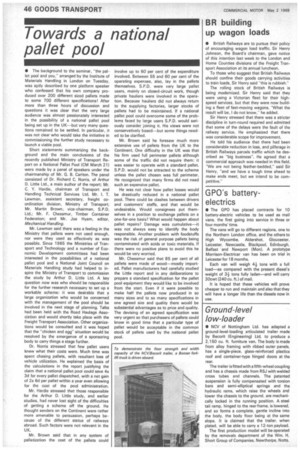Towards a national pallet pool
Page 48

If you've noticed an error in this article please click here to report it so we can fix it.
• The background to the seminar, "the pallet pool and you," arranged by the Institute of Materials Handling in London on Tuesday, was aptly described by one platform speaker who confessed that his own company produced over 200 different sized pallets made to some 700 different specifications! After more than three hours of discussion and questions it was clear that the very large audience was almost passionately interested in the possibility of a national pallet pool being set up in the UK--but very many questions remained to be settled. In particular, it was not clear who would take the initiative in commissioning the further study necessary to launch a viable pool.
Short statements summarizing the background and the main conclusions of the recently published Ministry of Transport Report on a National Pallet Pool (CM March 21) were made by a panel of speakers under the chairmanship of Mr. G. B. Carlton. The panel consisted of Dr. Richard C. Norris, of Arthur D. Little Ltd., a main author of the report; Mr. C. Y. Hardie, chairman of Transport and Handling Technical Services Ltd. Mr. I. T. Lawman, assistant secretary, freight coordination division, Ministry of Transport; Mr. Martin Brown; vice-chairman, S.P.D. Ltd.; Mr. F. Chessmur, Timber Container Federation; and Mr. Joe Hyam, editor, Mechanical Handling.
Mr. Lawman said there was a feeling in the Ministry that pallets were not used enough, nor were they used as effectively as was possible. Since 1965 the Ministries of Transport and Technology and a number of Economic Development committees had been interested in the possibilities of a national pallet pool and a National Joint Council on Materials Handling study had helped to inspire the Ministry of Transport to commission the study by Arthur D. Little Ltd. A key question now was who should be responsible for the further research necessary to set up a workable scheme: it was desirable that a large organization who would be concerned with the management of the pool should be involved in the next stage of planning. Talks had been held with the Road Haulage Association and would shortly take place with the Freight Transport Association. Other organizations would be consulted and it was hoped that the "chicken and egg" situation would be resolved by the emergence of a sponsoring body to carry things a stage further.
Dr. Norris stressed that few pallet users knew what their costs were. Much time was spent chasing pallets, with resultant loss of vehicle utilization. He explained the basis of the calculations in the report justifying the claim that a national pallet pool could save 4s 3d for every pallet dispatched, with a net gain of 2s 6d per pallet within a year even allowing for the cost of the pool administration.
Mr. Hardie stressed that those responsible for the Arthur D. Little study, and earlier studies, had never lost sight of the difficulties of getting a scheme off the ground. He thought senders on the Continent were rather more amenable to persuasion, perhaps because of the different status of railways abroad. Such factors were not relevant in the UK.
Mr. Brown said that in any system of palletization the cost of the pallets could involve up to 60 per cent of the expenditure involved. Between 55 and 60 per cent of the operating expenses, also, lay in the pallets themselves. S.P.D. were very large pallet users, mainly on closed-circuit work, though private hauliers were involved in the operation. Because hauliers did not always return to the supplying factories, larger stocks of pallets had to be maintained. If a national pallet pool could overcome some of the problems faced by large users S.P.D. would seriously consider joining it. His views were not conservatively based—but some things needed to be clarified.
Mr. Brown said he foresaw much more extensive use of pallets from the UK to the Continent. One difficulty in the UK was that his firm used full perimeter pallets although some of the traffic did not require them: it was easier to operate with a standard pallet. S.P.D. would not be attracted to the scheme unless the pallet chosen was full perimeter. He recognized that many firms did not need such an expensive pallet.
He was not clear how pallet losses would be drastically reduced in a national pallet pool. There could be clashes between drivers and customers' staffs, and that would be undesirable. Would consignees put themselves in a position to exchange pallets on a one-for-one basis? What would happen about pallet repairs? Damage was cumulative—it was not always easy to identify the body responsible. Another problem with foodstuffs was the risk of general purpose pallets being contaminated with acids or toxic materials. If there were no positive plans to avoid this he would be very worried.
Mr. Cheesmur said that 85 per cent of all pallets were made of wood—mostly imported. Pallet manufacturers had carefully studied the Little report and in any deliberations to prepare a standard specification for the pallet pool equipment they would like to be involved from the start. Even if it were possible to make half the pallets now produced in so many sizes and to so many specifications in one agreed size and quality there would be substantial advantages as to price and quality. The devising of an agreed specification was very urgent so that purchasers of pallets could know in good time that a particular type of pallet would be acceptable in the common stock of pallets used by the national pallet pool.




















































































































































































































